Though Lebanon has been swept by a gentrifying and disfiguring development rush, some older monuments still stand tall. Strolling downhill from the Clemenceau neighbourhood for a coffee on the seaside Corniche, you’ll see the towering building of the Holiday Inn: bullet-riddled and rocket-pierced.
The once-plush hotel, which opened for business just two years before the Lebanese civil war broke out in 1975, has remained in Beirut’s collective memory – not for its glamour or architectural design, but as a front-line, a demarcation between east and west, and a symbol of war.
The Holiday Inn represented an affluent time for the city: the building became part of a luxury developmental bubble at a time when Beirut’s banks were growing fat on deposits from the region’s petrodollars. However, the civil war obliterated the hotel’s ambitions of becoming a social hub, with cinemas and restaurants crowned by a rooftop rotating restaurant towering over the district.
In October 1975, just months into the Lebanese civil war, the hotel became part of an epic battle dubbed “the war of the hotels”. It lasted until March 1976 and mobilised around 25,000 fighters from both sides, resulting in more than 1,000 dead and 2,000 injured.

